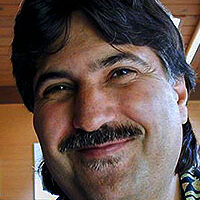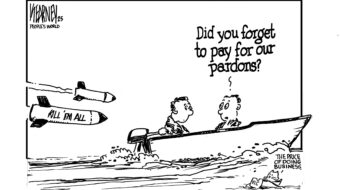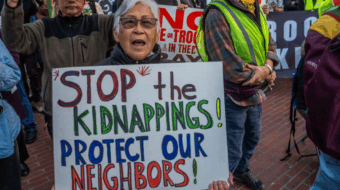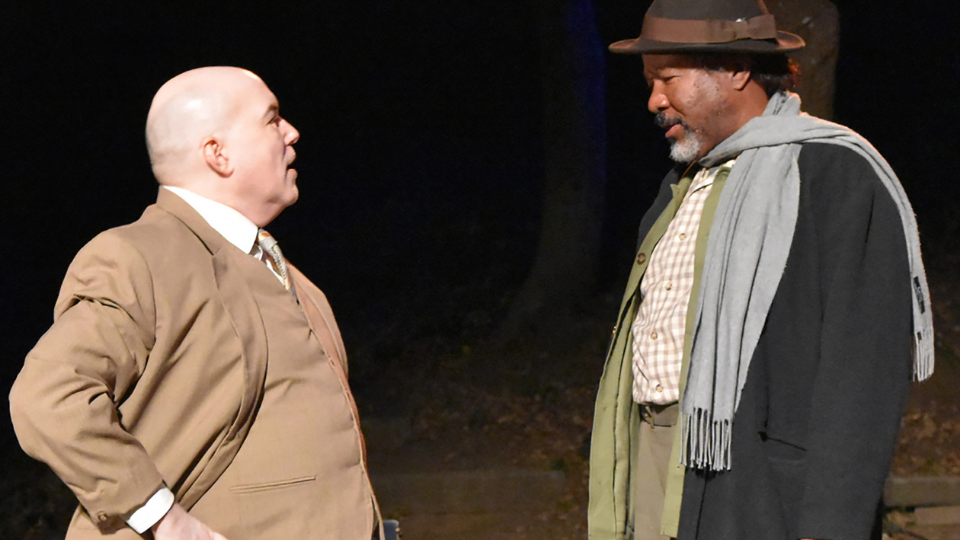
In 1931, during the Harlan County War, activist Florence Reese, wife of United Mine Workers’ organizer Sam Reese, wrote the classic labor ballad about the violent Kentucky strikes entitled “Which Side Are You On?” The lyrics include this verse:
“They say in Harlan County
There are no neutrals there
You’ll either be a union man
Or a thug for J. H. Blair.”
Blair was a vicious, reactionary sheriff who acted like the mine owners’ gun for hire. As in Reese’s song, in the great proletarian dramas—from Lope de Vega’s 1619 The Sheep Well to Bertolt Brecht’s 1931 The Mother to Clifford Odets’ 1935 Waiting for Lefty—in the class war, there are only two sides, in sharp conflict with one another: The haves and the have nots. But this is not the case in John Galsworthy’s 1909 Strife, which takes a more nuanced look at class struggle.
Galsworthy, who won the Nobel Prize in Literature in 1932 and is best known for the epic The Forsyte Saga, set Strife at the Trenartha Tin Plate Works, located at the borders of England and Wales. But the current production of Strife at Will Geer Theatricum Botanicum has Americanized the action and reset it in Pennsylvania in the 1890s (so if you want to hear English accents, tune in to BritBox instead). I assume that WGTB’s co-directors, Ellen Geer and Willow Geer, made these changes in time and place because this was a period of very fierce class warfare, when 1892’s Homestead Strike took place, pitting steelworkers against Andrew Carnegie (he of Hall fame) and the Pinkerton Detective Agency (the ICE of their day), with bloody confrontations near Pittsburgh. (“Homestead” is even mentioned in passing in what I suppose is this version of Strife’s revised dialogue.) In fact, the Homestead fracas grew so heated that Lithuanian-born anarchist Alexander Berkman (Emma Goldman’s lover) attempted to assassinate the Carnegie Steel Company’s operator Henry Clay Frick (he of the newly renovated Collection fame).
But while Strife dramatizes a strike, it is not a simple, clear-cut case of black and white, of Left vs. right, of labor vs. capital. Galsworthy’s original three-act play (here condensed to two acts, with one intermission) is far more complex. In it, the months-long industrial action is not led or even supported by the union, represented by Simon Harness (Brian Wallace). Indeed, the curiously monikered “Harness” jockeys for position with David Roberts (Gerald Rivers) as to who will ride in the saddle and play the walkout’s leadership role. While Harness pursues a more conventional trade unionist—and one could say “bureaucratic”—policy, Roberts is a firebrand who advocates more militant direct action against the bosses. The rabblerouser has led the rank and file of the workers in what appears to be a wildcat strike—that is, an industrial action that’s more spontaneous in nature, unauthorized by a union hierarchy.
On the other hand, the drama’s board of directors is likewise divided between hardliners and accommodationists. The longtime bearded, unbending chairman of the board, Franc Ross’ 76-year-old John Anthony (is Galsworthy making a reference to Marc Antony here?) advocates a scorched Earth, iron-fisted strategy in order to bring the strikers to heel. But other members of the board, such as his son Edgar Anthony (Roman Guastaferro), have more of a corporate temperament. This faction is willing to make a bargain in order to end the strike, which they see as being bad for business and harming the “dividends” of “the shareholders.” These capitalists are personified by hypocritical William Scantlebury (played by wily stage stalwart Alan Blumenfeld, an opportunist in a plaid suit anxious that he not be publicly perceived as “inhumane,” even as he benefits off of exploiting and even starving his company’s employees, as long as the profits keep rolling in and his public image not be sullied.
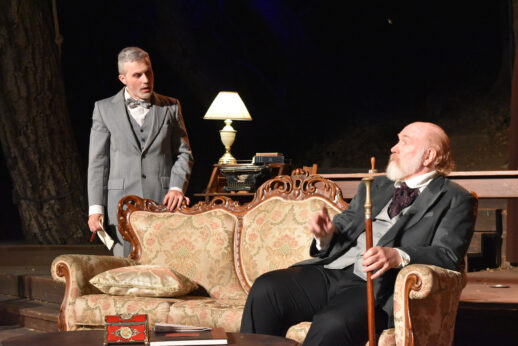
To be fair, Edgar and his sister Enid Underwood (Emily Bridges), who is married to the company’s manager, Francis Underwood (Sam Cowan), also evince genuine concern and sympathy for the downtrodden strikers, who are enduring harsh hardships during their long walkout. Enid even goes to visit her former maid, David’s ailing wife, Annie Roberts (played by the long-suffering Earnestine Phillips). Emily, who is the daughter of showbiz royalty, epitomizes Strife’s divided loyalties, but as a daughter (literally) of the ruling class, is most concerned with her aging father’s well-being. As a son of Britain’s upper middle class who had a conscience and consciousness, these characters probably reflect Galsworthy most, and his ability to look at both sides of the issue.
Although Berkman’s assassination effort is never depicted in Strife, the events that transpired during the Homestead Strike do appear to have influenced Galsworthy, who was noted for being a playwright and novelist interested in pressing societal issues.
Strife’s theme explores compromise versus unyielding stances, the “Let’s make a deal” versus the “by any means necessary” ethos. As Rosa Luxemburg put it in her 1899 pamphlet, is the road forward “Social Reform or Revolution”?
John Anthony and David Roberts may be on opposite sides of the class divide, but personality-wise, Galsworthy’s zealots seem cut from the same “stand your ground” cloth. Although theatergoers have recently been treated to the opportunity to enjoy Gerald Rivers on stages here and there, he is best known for reenacting Rev. Martin Luther King. But Rivers’ Roberts is more Stokely Carmichael or Huey P. Newton than he is Dr. King or Gandhi.
The Geers’ well-directed topical production about a strike is “uncannily relevant in today’s world” (as WGTB’s “Director’s Notes” puts it; the Geers are descended from a legendary figure of the labor movement, Mother Bloor, who is depicted in WGTB’s 1995 play . . .and the Dark Cloud Came). Strife is especially of the moment for this period of protest, which is only likely to intensify as the masses resist the ICE raids and the austerity that the Trump administration is imposing on the working class. As Mick Jagger sang in the song “Street Fighting Man”: “Everywhere I hear the sound of marching, charging feet, boy ’Cause summer’s here and the time is right For fighting in the street, boy.”
The thought-provoking Strife asks an important question: What path is more successful for those engaged in social movements, what yields more results for the wretched of the Earth? The lyrics of “Street Fighting Man” ask if “the game to play… Is Compromise solution” or is it “called Disturbance I’ll shout and scream, I’ll kill the king I’ll rail at all his servants”?
Strife examines both sides of the class struggle. But as far as this “poor boy” is concerned, I couldn’t care less what the ruling class’s point of view is. I don’t want to understand the capitalists. I just want to overthrow them.
Will Geer Theatricum Botanicum is presenting Strife through October 4 in repertory with: Much Ado About Nothing, A Midsummer Night’s Dream; Wine in the Wilderness and an adaptation of Chekhov’s The Seagull set in 1970s Malibu, which premieres Saturday, July 12 at 1419 North Topanga Canyon Blvd., Topanga, California 90290. For info and tickets, call 310-455-3723 or go here.
We hope you appreciated this article. At People’s World, we believe news and information should be free and accessible to all, but we need your help. Our journalism is free of corporate influence and paywalls because we are totally reader-supported. Only you, our readers and supporters, make this possible. If you enjoy reading People’s World and the stories we bring you, please support our work by donating or becoming a monthly sustainer today. Thank you!


